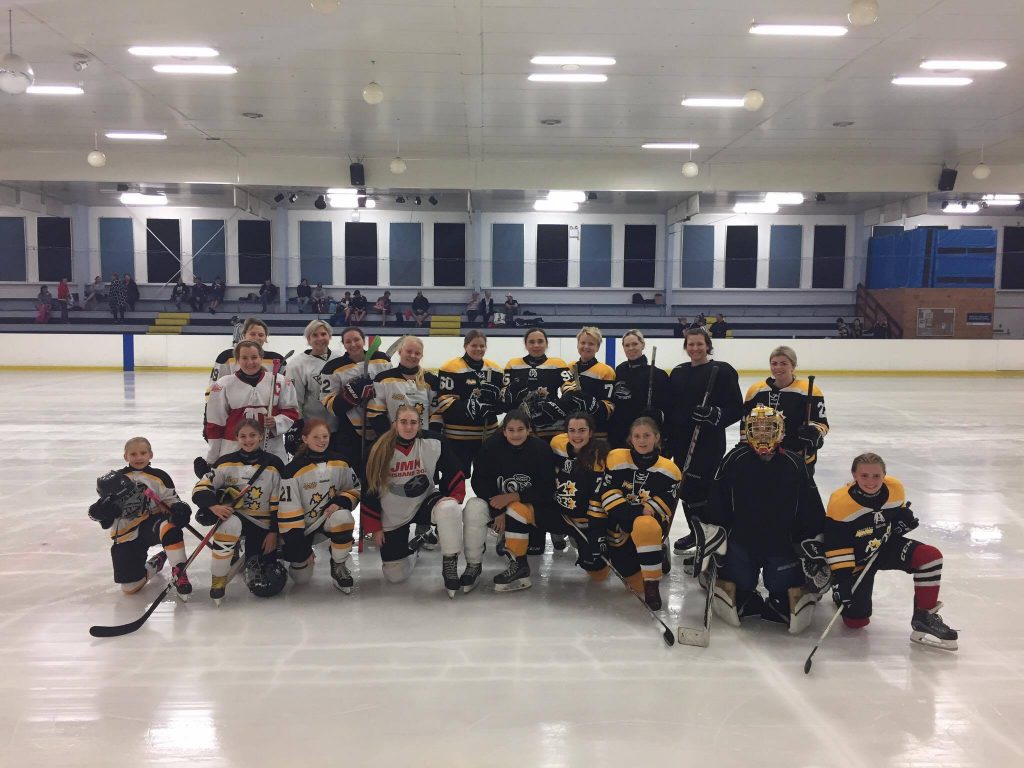Proud to see my partner and daughter on the ice for an all womens’ hockey game Sunday in Brisbane.
‘It’s a super-cool study’ Salmonella took down the Aztecs
Eye herpes is a real thing.
Probably from my ex roomate’s towel.
I was so sick for two weeks, although I did manage to crawl out of bed for a Neil Young show in Toronto (part of the International Harvesters tour) but then felt so sick afterwards I went home to Brantford.
One of my parent’s neighbours was my evy doctor, so I was in for a regular check-up and he detected it immediately.
Put me on some Acyclovir, which had just come out, and I was cured in no time.
Or temporarily. Viruses don’t go away.
We’re all hosts on a viral planet.
Mine has come back, in the form of a cold sore, probably because of the stress of buying a new house in an over-heated real-estate market and not selling ours.
I went to the chemist, got some drugs that aren’t really working, but at least I had that option.
Imagine 600 years ago, when Cortez from Spain dances across the water to what is now Mexico and there’s no chemist down the road.
Ewen Callaway of Nature writes one of the worst epidemics in human history, a sixteenth-century pestilence that devastated Mexico’s native population, may have been caused by a deadly form of salmonella from Europe, a pair of studies suggest.
In one study, researchers say they have recovered DNA of the stomach bacterium from burials in Mexico linked to a 1540s epidemic that killed up to 80% of the country’s native inhabitants. The team reports its findings in a preprint posted on the bioRxiv server on 8 February.
This is potentially the first genetic evidence of the pathogen that caused the massive decline in native populations after European colonization, says Hannes Schroeder, an ancient-DNA researcher at the Natural History Museum of Denmark in Copenhagen who was not involved in the work. “It’s a super-cool study.”
In 1519, when forces led by Spanish conquistador Hernando Cortés arrived in Mexico, the native population was estimated at about 25 million. A century later, after a Spanish victory and a series of epidemics, numbers had plunged to around 1 million.
The largest of these disease outbreaks were known as cocoliztli (from the word for ‘pestilence’ in Nahuatl, the Aztec language). Two major cocoliztli, beginning in 1545 and 1576, killed an estimated 7 million to 18 million people living in Mexico’s highland regions.
“In the cities and large towns, big ditches were dug, and from morning to sunset the priests did nothing else but carry the dead bodies and throw them into the ditches,” noted a Franciscan historian who witnessed the 1576 outbreak.
There has been little consensus on the cause of cocoliztli — although measles, smallpox and typhus have all been mooted. In 2002, researchers at the National Autonomous University of Mexico (UNAM) in Mexico City proposed that a viral haemorrhagic fever, exacerbated by a catastrophic drought, was behind the carnage2. They compared the magnitude of the 1545 outbreak to that of the Black Death in fourteenth-century Europe.
In an attempt to settle the question, a team led by evolutionary geneticist Johannes Krause at the Max Planck Institute for the Science of Human History in Jena, Germany, extracted and sequenced DNA from the teeth of 29 people buried in the Oaxacan highlands of southern Mexico. All but five were linked to a cocoliztli that researchers think ran from 1545 to 1550.
Ancient bacterial DNA recovered from several of the people matched that of Salmonella, based on comparisons with a database of more than 2,700 modern bacterial genomes.
Further sequencing of short, damaged DNA fragments from the remains allowed the team to reconstruct two genomes of a Salmonella enterica strain known as Paratyphi C. Today, this bacterium causes enteric fever, a typhus-like illness, that occurs mostly in developing countries. If left untreated, it kills 10–15% of infected people.
It’s perfectly reasonable that the bacterium could have caused this epidemic, says Schroeder. “They make a really good case.” But María Ávila-Arcos, an evolutionary geneticist at UNAM, isn’t convinced. She notes that some people suggest that a virus caused the cocoliztli, and that wouldn’t have been picked up by the team’s method.
Krause and his colleagues’ proposal is helped by another study posted on bioRxiv last week, which raises the possibility that Salmonella Paratyphi C arrived in Mexico from Europe.
A team led by Mark Achtman, a microbiologist at the University of Warwick in Coventry, UK, collected and sequenced the genome of the bacterial strain from the remains of a young woman buried around 1200 in a cemetery in Trondheim, Norway. It is the earliest evidence for the now-rare Salmonella strain, and proof that it was circulating in Europe, according to the study. (Both teams declined to comment on their research because their papers have been submitted to a peer-reviewed journal – good for them, dp).
“Really, what we’d like to do is look at both strains together,” says Hendrik Poinar, an evolutionary biologist at McMaster University in Hamilton, Canada. And if more ancient genomes can be collected from Europe and the Americas, it should be possible to find out more conclusively whether deadly pathogens such as Salmonella arrived in the New World from Europe.
Strunk and White never goes out of style
For the thousands of students I have had the privilege of teaching over the past three decades, a reminder: read Strunk and White, and know it inside out.
 For assignments, I always gave 60% for content, 40% for style.
For assignments, I always gave 60% for content, 40% for style.
So learn to fucking spell and write in coherent sentences, or stop wasting my — or anyone else’s — time.
I miss you: But barfblog needs to stop living in my basement
Hated the song, Miss You, when it came out on Some Girls, the go-to Stones album of my high-school yout in 1978, but saw them live in Buffalo in 1981 and they rocked it up and I sorta got it.
 Respcectable is much better from Some Girls.
Respcectable is much better from Some Girls.
Journey still sucks.
barfblog.com will be back, but a little different.
No longer tied to any sponsorship, academic or anyone.
(Chapman is, but he needs his job; I don’t).
I’m Canadian. Get used to the fucking swearing or get the fuck off.
A few years ago at the International Association for Food Protection annual meeting, I told the audience, after revealing my wife’s breast size because she asked me to shop for bras – which I did — that the audience of food safety geeks now knew more about my wife’s breast size than they knew about the food they were about to eat for dinner, where it came from, and how it was prepared.
A government-type said she couldn’t read me anymore.
Then don’t.
Or the way 1.5 million attended my farewell blog.
But a few thousand have written in so:
After 25 years of food safety risk communication, nothing has changed.
A self-congratulating-largely-taxpayer-funded crowd to tell people food safety is their fault is not a movement.
Cut-and-paste press releases do not make a publication, regardless of medium – and I’ll take on anyone who wants to talk the medium is the message by University of Toronto prof Marshall McLuhan.
I miss you probably not in the same way Jamie Oliver misses his parents, who own The Cricketers Pub in Essex, England, and was downgraded from the highest rating of 5 to 2 for poor hygiene after inspectors found dead uncooked pheasants next to pre-cooked potato chips, frozen chicken that expired three months ago, and dirt and grease through tout the kitchen.
Then there’s the academics, going on about food safety culture, about eight-years after it jumped the shark.
I’ll let the abstract speak for itself:
In an intensifying climate of scrutiny over food safety, the food industry is turning to “food safety culture” as a one-size-fits-all solution to protect both consumers and companies. This strategy focuses on changing employee behavior from farm to fork to fit a universal model of bureaucratic control; the goal is system-wide cultural transformation in the name of combatting foodborne illness. Through grounded fieldwork centered on the case of a regional wholesale produce market in California, we examine the consequences of this bureaucratization of food safety power on the everyday routines and lived experiences of people working to grow, pack, and deliver fresh produce. We find that despite rhetoric promising a rational and universal answer to food safety, fear and frustration over pervasive uncertainty and legal threats can produce cynicism, distrust, and fragmentation among agrifood actors. Furthermore, under the cover of its public health mission to prevent foodborne illness, food safety culture exerts a new moral economy that sorts companies and employees into categories of ‘good’ and ‘bad’ according to an abstracted calculation of ‘riskiness’ along a scale from safe to dangerous. We raise the concern that ‘safety’ is usurping other deeply held values and excluding cultural forms and experiential knowledges associated with long-standing food-ways. The long-term danger, we conclude, is that this uniform and myopic response to real risks of foodborne illness will not lead to a holistically healthy or sustainable agrifood system, but rather perpetuate a spiralling cycle of crisis and reform that carries a very real human toll.
Oh Fonz.
7-minute abs, not 6: Shortest bullshit workout possible
Gretchen Reynolds of the NY Times writes that super-short workouts are a favorite topic in this column. I have written about seven-minute, six-minute, four-minute, and even one-minute workouts. They are appealing because they require so little time, but they also demand straining effort.
 Martin Gibala is the scientist we most have to thank for the popularity of very brief, very hard exercise. All of these workouts are built around the concept of high-intensity interval training, in which you push yourself almost to exhaustion for a brief spurt of minutes or seconds, and then rest and recover for a few minutes before repeating the intense interval.
Martin Gibala is the scientist we most have to thank for the popularity of very brief, very hard exercise. All of these workouts are built around the concept of high-intensity interval training, in which you push yourself almost to exhaustion for a brief spurt of minutes or seconds, and then rest and recover for a few minutes before repeating the intense interval.
Athletes have long used interval sessions as part of a varied weekly training program to improve their competitiveness. But Dr. Gibala, a professor of kinesiology at McMaster University in Hamilton, Ontario, has helped to popularize the idea that we can rely on high-intensity intervals as our only exercise, and do very, very few of them while still improving our health and fitness.
Since 2004, he has published multiple studies about the potent effects of intervals.
But McMaster? Shithole Hamilton?
Food Safety Talk 119: It’s Purple, I Visited It
Don and Ben talk passion, flushing habits, ceviche, flour, cookie dough, Listeria and posting warning letters.
Episode 119 can be found here and on iTunes.
Show notes so you can follow along at home:
- Super Bowl LI
- Hunt for the Wilderpeople
- The Castle
- Love It or List It
- Portlandia (season 7)
- Sean Spicer Press Conference (Melissa McCarthy)
- Pod Save the World
- Woman, prosecuted for ceviche sales on Facebook, settles with DA | Ars Technica
- Woman, prosecuted for selling $12 of ceviche on Facebook, now faces trial | Ars Technica
- Conference Agenda | CFSEC 2017
- Iowa cookie dough supplier shuts down after listeria outbreak
- FDA Warning Letter 2017 > Aspen Hills, Inc. 1/10/17
- cookiedough.com – by Aspen Hills, Inc., Garner – Iowa
- Watch: Lady Gaga’s Super Bowl halftime show reminded America she’s a star – Vox
- Verizon FiOS rolls out 500/100 Mbps broadband, its highest speed tier yet
Salmonella in deep-fried ice cream sickens 100 in Brisbane: Happy Chinese New Year
Deep-fried ice cream sounds like something from a U.S. state fair, where everything is deep-fried, but in times of relative truths, decreasing skepticism and declining media coverage, the idea that over 100 people in Brisbane are sick from Salmonella, and that I found out about it from a hockey parent rather than public-health types is disturbing.
We have a paper coming out in April about the importance of going public with health information, so fewer people barf, but that lesson is increasingly lost.
Part of that paper includes a couple of Australian outbreaks: When 264 were sickened at a principals conference in Brisbane because they were fed some raw-egg dip, and when over 100 people were sickened with deep-fried ice cream at Chin-Chins in Brisbane in 2015.
There has been no public reporting that I can find, but at some time, public-health types and bureaucrats will realize they are paid by taxpayers, their job is to prevent people barf, not cover and hide.
According to a hockey parent, 15 teachers are out at their son’s school after dining on deep-fried ice cream in the Sunnybank suburb of Brisbane a week or so ago.
The diagnosis is Salmonella and over 100 are believed to be sickened.
Or maybe it’s just fake news, but everyone has a camera and social media, so these stories spread.
Maybe our public health types, or their bosses, with their supers (RSP) can take some steps to protect public health, rather than their own asses.
A table of Australian egg outbreaks is available at https://barfblog.com/wp-content/uploads/2015/03/raw-egg-related-outbreaks-australia-3-2-15.xlsx=
Food Safety Talk 118: Hand Size Matters
This episode has you covered from the top of your head to the tips of your lucky socks. Ben and Don dig into some 1980’s culture and shoot forward into the food on the future, and then back again. It’s a food (and pet) safety grab bag covering pineapple safety, hand sizes and hand sanitizers, safe raw cookie dough, rats, turtles, milk from camels, microgreens and toilet history.
Episode 118 can be found here and on iTunes.
Here are some links so you can follow along at home.
- Socks
- Miami Vice
- eero – WiFi
- Dippin’ Dots
- Sean Spicer’s Dippin’ Dots Tweets Put Press Secretary On The Spot : NPR
- Dippin’ Dots open letter
- Say Anything…
- Ill Communication by Beastie Boys on Apple Music
- Pod Save America
- sciencecafes.org
- Science Cafe: You cannot B. cereus: Microbial food safety in the modern world
- Lunds & Byerlys Pulls ‘Fresh-Cut Cored Pineapple’ after Voluntary Recall | KSTP.com
- Growth Potential of Listeria Monocytogenes and Staphylococcus Aureus on Fresh-Cut Tropical Fruits
- USDA Scientists Have Been Put On Lockdown Under Trump
- You Aren’t Using Enough Hand Sanitizer
- Hand coverage by alcohol-based handrub varies: Volume and hand size matter
- Gorge On Cookie Dough In All Its Forms At This NYC Eatery
- Spaceballs (1987)
- Not Even Scientists Can Easily Explain P-values
- CDC: Pet rats linked to virus outbreak
- FDA Bets It Will Escape Coming Political Hurricane, Targets Raw Camel Milk
- FDA Compliance & Enforcement on Salmonella and Turtle SafetyNC rule on pet turtles
- The History of ‘Toilet’ on Merriam-Webster
- Microgreens, Elevator, This Old House
Going public: A reader complains
Donald Trump is the Sid Vicious of Presidents. Can barely play the bass, all show, will probably OD.
I’ve kept a low profile and will continue, but when someone responds to a blog post about USDA food safety scientists being muzzled, and says I should stick to food safety, I will use my pulpit to say something.
We have a paper that has been years in the making, has been peer-reviewed, accepted and will be published in April, that talks all about going pubic.
But I’m not about to break my ban on press release before publication.
Pete Townsend’s Rough Boys was his response to Sid, The Sex Pistols and punk. Neil Young’s Into the Black was his response.
Punk went nowhere. Rock will last.
If you can’t see the link between popular culture, and the kid making minimum wage serving your lunch, then you must really believe in faith-based food safety. Praise the Lord and pass the guacamole — or ammo.
Saw Neil on this tour in 1991 in Toronto.
Took Chapman to a Neil concert in the 2000s. It’s what responsible graduate student advisors do.
dp
You should probably stick to writing about Food Safety.
On Tue, Jan 24, 2017 at 7:16 PM Doug Powell <dpowell29@gmail.com> wrote:
Summary:
For the many who have asked, barfblog.com is on hiatus while I chill and focus on other things.
But some things deserve a wide audience.
Buzzfeed reports the U.S. Department of Agriculture has banned scientists and other employees in its main research division from publicly sharing everything from the summaries of scientific papers to USDA-branded tweets as …
View the entire entry:
==============================================
Unsubscribe jharris58@gmail.com from this list:
The chill started in Kansas, I live in Australia: USDA scientists have been put on lockdown under Trump
For the many who have asked, barfblog.com is on hiatus while I chill and focus on other things.
But some things deserve a wide audience.
Buzzfeed reports the U.S. Department of Agriculture has banned scientists and other employees in its main research division from publicly sharing everything from the summaries of scientific papers to USDA-branded tweets as it starts to adjust to life under the Trump administration.
According to an email sent Monday morning and obtained by BuzzFeed News, the department told staff — including some 2,000 scientists — at the agency’s main in-house research arm, the Agricultural Research Service (ARS), to stop communicating with the public about taxpayer-funded work.
“Starting immediately and until further notice, ARS will not release any public-facing documents,” Sharon Drumm, chief of staff for ARS, wrote in a department-wide email shared with BuzzFeed News.
“This includes, but is not limited to, news releases, photos, fact sheets, news feeds, and social media content,” she added.
Indeed, the last tweet from ARS’s official account was sent the day before Trump’s inauguration on Jan. 20.
Though the terse internal note did not explicitly mention the new presidential administration, department scientists around the country interpreted it as a message from Trump that changes were coming to the department.
The memo was also met with some confusion. When asked if the notice constituted a halt on the publication of academic articles, one regional director told scientists that research papers could be published in academic journals and presented at conferences, but that all media interviews must be approved by the office of communications in Washington.
In a statement on Tuesday to BuzzFeed News, the department acknowledged sending an internal email that halted the release of “informational products like news releases and social media content” on Monday. “Scientific publications, released through peer reviewed professional journals are not included,” he added.
“As the U.S. Department of Agriculture’s chief scientific in-house research agency, ARS values and is committed to maintaining the free flow of information between our scientists and the American public as we strive to find solutions to agricultural problems affecting America,” Christopher Bentley, a spokesperson for ARS, said in the statement.
The Netherlands thing is hilarious. Thanks, Amy.



